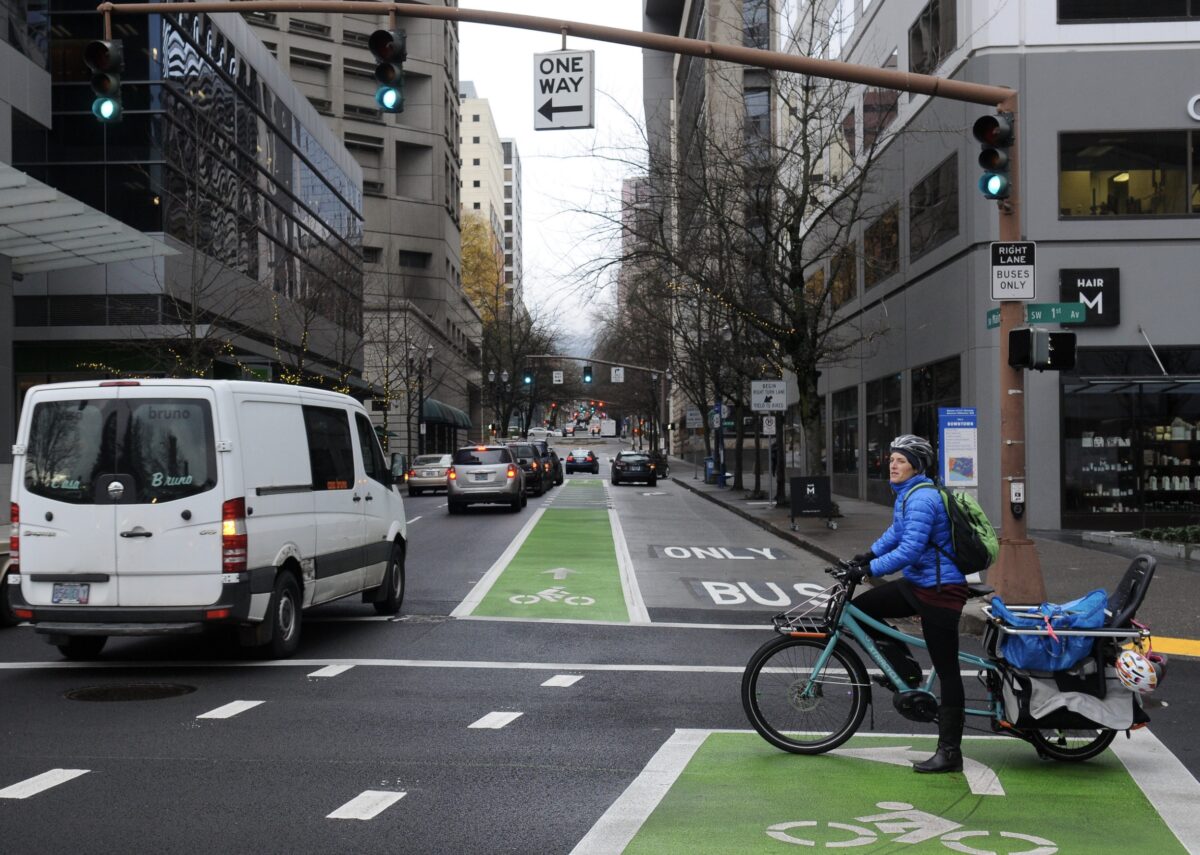
“In the old days, paving projects were just paving projects and it was very hard to do any of these enhancements.”
– Zef Wagner, PBOT
A significant evolution in how the Portland Bureau of Transportation operates could have a major impact on bicycling.
At Tuesday night’s Bicycle Advisory Committee meeting, PBOT Planner Zef Wagner shared an early look at a fledgling new program within the agency that could dramatically boost the quality of our transportation network with bike lanes on major commercial streets and neighborhood collectors. They’re calling it the “paving leverage program” and it would institutionalize what has so far been an ad hoc approach by opportunistic, forward-thinking staff.
Some of the projects on PBOT’s radar are game-changers and could bring protected bike lanes to streets including: inner NE Broadway, NE Sandy Blvd, N Interstate, SE Milwaukie, and many others.
The idea is to work closely with PBOT’s Maintenance Operations (MO) division to do lane reconfigurations, striping changes, and street design updates as part of repaving projects. BikePortland readers are familiar with this concept because you’ve read about it happening several times in recent years on projects like SE Main, SE Hawthorne, and most recently (as in, yesterday) NE Killingsworth. In each of those examples, PBOT leveraged a planned paving project to take a broader look and consider whether bike lane (and related) updates could be added. When MO crews grind off the top layer of a street for a paving project, they have no obligation to replace it with the same lane striping as before.
It’s as simple as taking advantage of a clean slate to create a street that more closely aligns with PBOT’s goals and vision. Now PBOT wants to make that approach standard operating procedure.
“In the old days, paving projects were just paving projects and it was very hard to do any of these enhancements,” Wagner said at the meeting last night. “But now we’re working much closer with our pavement crews and planning these things together. And they’re being they’ve been very gracious and sort of entertaining our wild ideas for street redesigns.” Wagner said in the past, MO would only release their street paving project list one year in advance, which didn’t give PBOT planners time to assess the feasibility of changes. Now, for the first time ever, the MO Division has released a five-year list of paving projects. “Now we can really plan ahead and take the time we need,” Wagner said.
On that note, Wagner asked BAC members at the meeting to share feedback on which specific projects PBOT should pursue (see the list below). Wagner highlighted several projects he feels are especially promising candidates for major bike lane upgrades (the projects could also come with non-bike stuff like transit upgrades, street trees, crossing enhancements, and so on).
As you look through the projects, keep in mind that PBOT approaches them with an understanding that the ultimate scope of the changes is limited by funding and staff capacity. “We need to work within the limits of the paving project and timeline… we’re not going to do a bunch of moving curbs, raised cycle tracks, you know all these kinds of like things that are larger capital projects,” Wagner cautioned. In his view, the idea is to claim the space for the bikeway now, and seek more funding to upgrade it in the future.
The projects below (listed by year of construction with graphics from PBOT’s presentation) are the ones Wagner said PBOT staff have already identified as “really good and clear opportunities”:
2023
The projects below are already design and planned. There’s no ability to influence them, so Wagner didn’t share any concept designs.
NE 33rd from NE Brazee to NE Liberty: This project will include an offset bike crossing at Mason and Skidmore and buffered bike lanes north of Holman! This is great news because NE 33rd is a key connection to the popular Marine Drive bike path and this short gap between Holman and Lombard was always the most sketchy part of the ride.
NW St Helens Rd from Lakeview to Yeon: PBOT plans to narrow existing general purpose lanes and add buffers to widen the bike lanes.
NE Alderwood Rd from 82nd to 105th: PBOT plans to narrow existing general purpose lanes and add buffers to widen the bike lanes.
SE Stark St from 86th to 117th and SE Washington St from 82nd to Stark: PBOT plans to add and improve bike lanes on both streets through Montavilla and Gateway
2024
The projects below are set for paving in 2024. Wagner said there’s still time to influence their design but we’ll have to move relatively fast in terms of design debates and public process.
NE Broadway from 11th to 24th Avenue

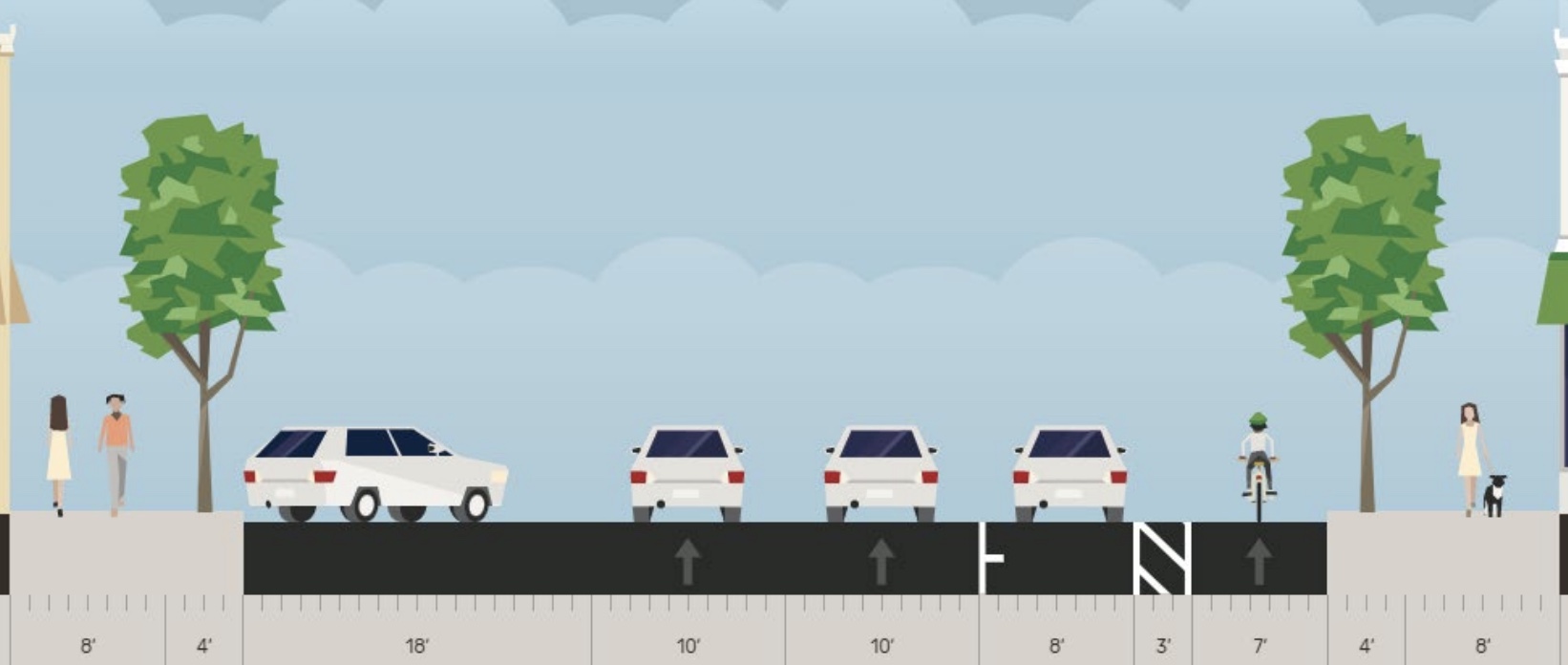
This would be an amazing addition to the bike network, especially if we can get protected bike lanes all the way to existing ones on NE 7th and eventually tie it into the changes coming as part of the I-5 Rose Quarter. Wagner said there’s enough room to do a wider, parking-protected bike lane just by narrowing the existing general purpose lanes. “That would be the least impactful to the neighborhood and traffic,” he said. But keeping all three lanes for drivers would mean it stays unsafe. One option he shared would be to create a diagonal parking lane on the south side. “This would help mitigate the loss of a lot of parking on the north side… And so this might be an option that the business community could get behind even though it’s removing a travel lane… Diagonal parking can also have a traffic calming effect because you have to drive pretty carefully next to it.”
NE Weidler St: 15th to 20th
PBOT could narrow travel lanes to buffer and widen the existing bike lane. Adding physical protection like curbs or flex posts could happen, but more funding would be needed.
SE 52nd Ave: Flavel St to Duke St

There’s an opportunity at this location to remove parking on one side and widen existing bike lanes. One option would be to have the parking protected bike lane on one side and just a protected bike lane on the other side, which would require removing parking on one side of the street.
NE Halsey St: 119th Ave to 132nd Ave
PBOT has already recommended removing on-street parking and widening the existing bike lanes here in their East Portland Arterial Streets Strategy (EPASS) plan.
NE 122nd Ave: Glisan St to Broadway
Wagner said they recommended removing on-street parking in this section because it’s not well-used. That would give them space for wide buffered bike lanes, or something more protected if they could find additional funding.
2025
Projects slated for 2025 give PBOT even more time to do analysis and find funding to make sure the street is replaced with a much better design.
SE 11th Ave: Caruthers St to Mill St
Already called for in the Central City in Motion Plan, PBOT would repurpose an existing lane for a buffered bike lane. Design would feel similar to N Williams or N Vancouver (parking-protected bike lane not possible here due to emergency response needs).
NE Glisan St: 84th Ave to I-205
PBOT would repurpose existing lanes to create protected bike lanes from the 80s bikeway to the I-205 path and eventually existing bikeways on 102nd Ave.
N Interstate Ave: Killingsworth St to Dekum St
Wagner called this an opportunity to swap on-street parking in order to “fill a critical bikeway network gap.” Planning has already begun for this project through the North Portland in Motion Plan. Due to existing curb extensions, left-turn lanes, and MAX platforms, the bike lane would get squeezed at intersection. That’s just one reason this would be a tricky project. “It requires a lot of parking removal in an area that’s seeing a lot more housing growth and so we know that this one will get a lot of concerns from the surrounding community,” Wagner said.
N Portsmouth Ave: Lombard St to Willamette Blvd
PBOT would swap on-street parking on one side of the street for a parking protected bike lane, which would also create space for more median islands to make crossings safer.
N Willamette Blvd: Carey Blvd to Portsmouth Ave
PBOT sees this paving project as an opportunity to get a jump on the federally funded Willamette Active Transportation Corridor which is slated for 2026. The idea is to install buffered bike lanes one year early, in 2025, then come back and add the concrete separation with federal funding one year later.
2026
NE Sandy Blvd: 14th to 27th


This would be huge! Wagner said it’s good this isn’t slated until 2026 because it would require a lot of planning and juggling of various needs given Sandy’s importance for so many people. He also said it’s an opportunity to extend this to the west to connect with the new bus/bike only lanes on NE 12th and Couch and then east to the 20s Bikeway. One option is to repurpose existing lanes and add parking-protected bike lanes in both directions. Or to remove one side of parking and add a center turn lane.
SW 2nd Ave: Columbia St to Alder St
This project would give PBOT the opportunity to extend the existing west side parking-protected bike lane south from Alder to Columbia.
SE Morrison St: Grand Ave to 13th Ave
Wagner is hopeful this project would give PBOT the chance to fulfill the recommendation from the Central City motion plan and further reduce driving space while making an even better bus and bike lane.
SE Milwaukie Ave: Bush St to Powell Blvd
This project gives PBOT a chance to make major changes to Milwaukie right through the heart of the Brooklyn neighborhood. To create bike lanes, the on-street parking would need to be removed in some sections. The cross-section varies widely on this stretch of Milwaukie so Wagner didn’t share any design concepts. He did say however, “I think this is such an important street to the Brooklyn neighborhood and I think there’s lots of different ideas people have about what they want that street to look and feel like. I think some people would really want curb extensions rather than bike lanes, for example. Or more trees, things like that. So it’s something that we’d have to have a lot of community conversations about but we have a lot of time for this one.”
Next Steps
From here, Wagner and his team will try to whittle down the paving project list and focus on the ones with the most potential. PBOT will also try to get a pot of set-aside funding through the Fixing Our Streets (gas tax) program to create the new Paving Leverage Program. This will allow staff to put together a multi-year schedule to plan and develop projects and create a work program going forward.
If you have feedback on these projects or questions for Wagner, he can be reached via email at zef.wagner@portlandoregon.gov



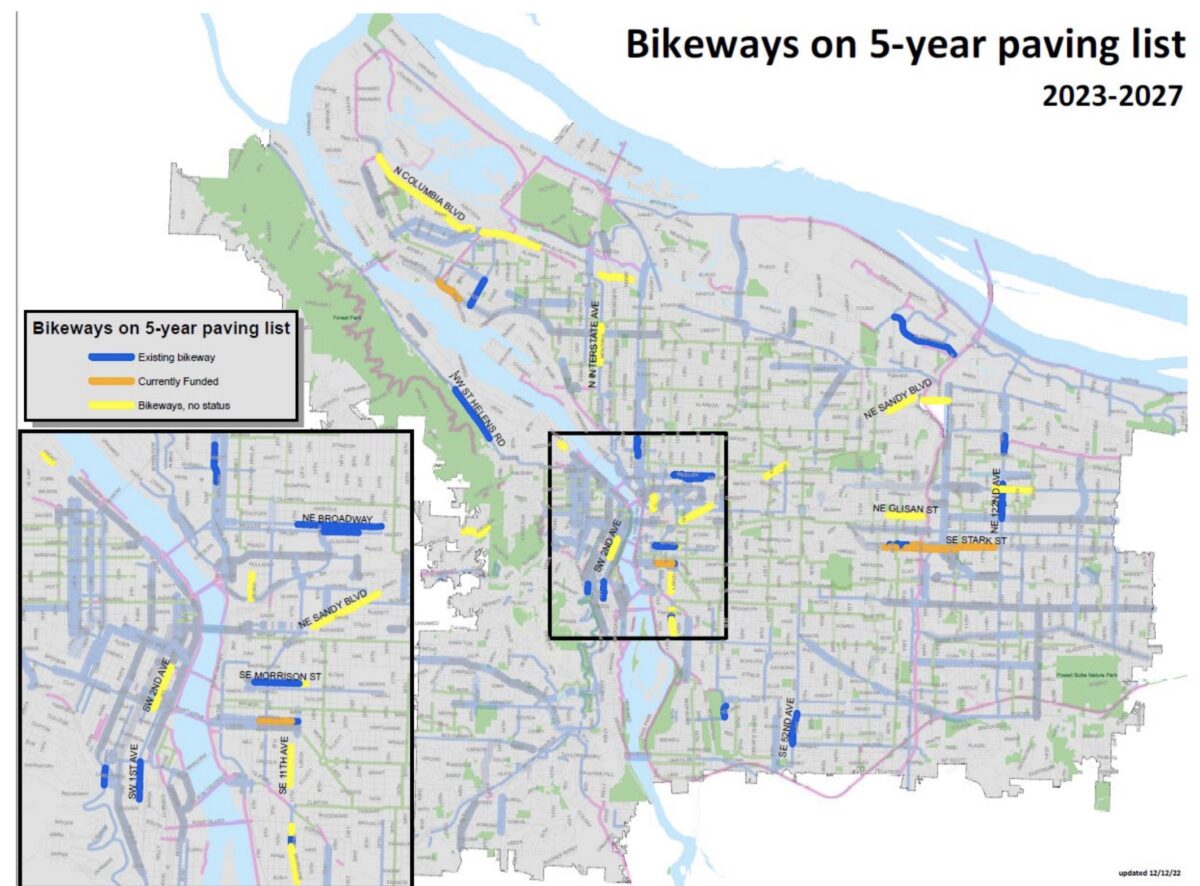






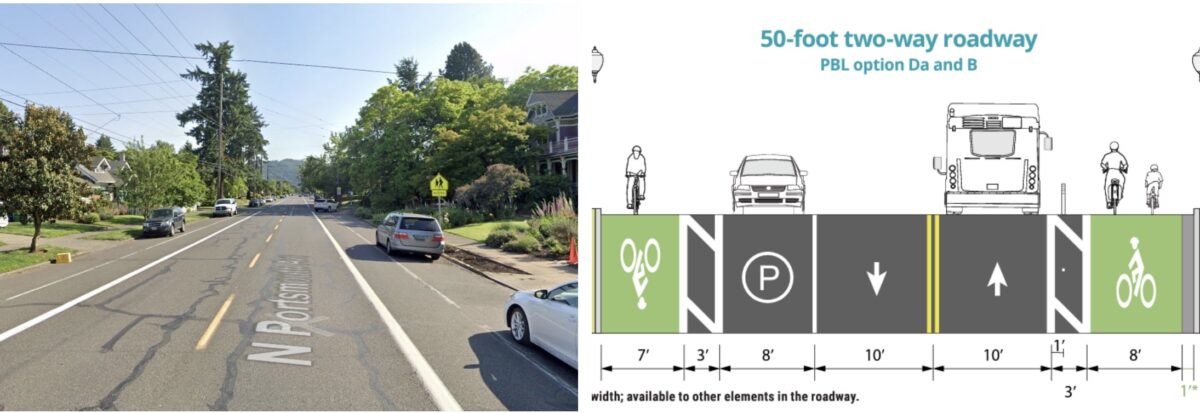
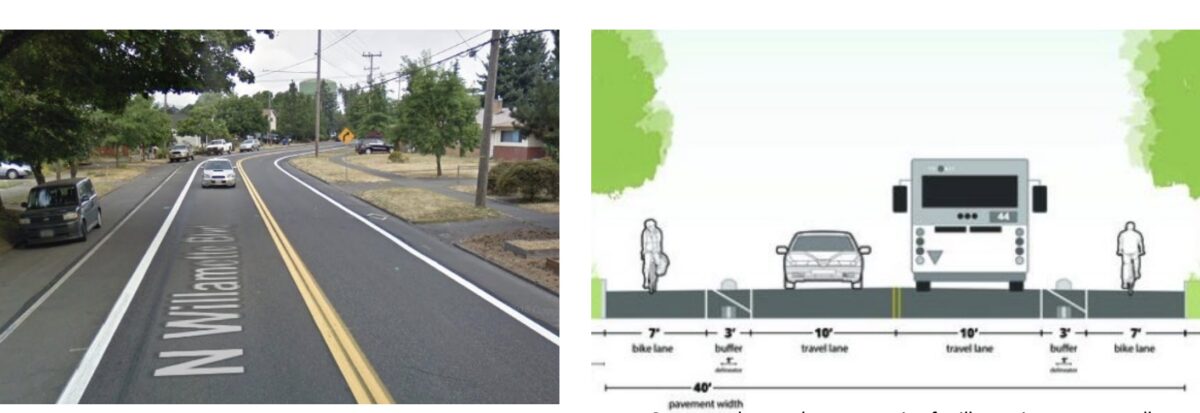



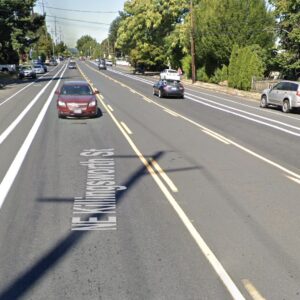
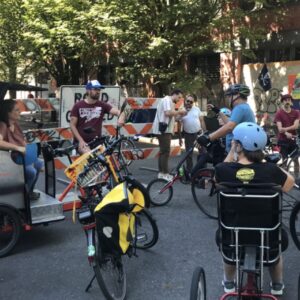
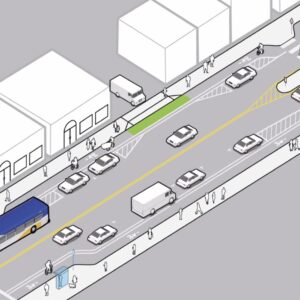
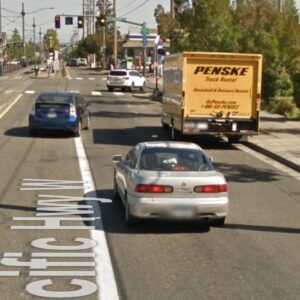
Thanks for reading.
BikePortland has served this community with independent community journalism since 2005. We rely on subscriptions from readers like you to survive. Your financial support is vital in keeping this valuable resource alive and well.
Please subscribe today to strengthen and expand our work.
It’s surprising that the stretch of Milwaukie is ending at Bush. The road surface is in really bad condition from about Bush to Holgate (old streetcar tracks are visible, which is fun trivia but not fun for biking!). Really weird/frustrating that PBOT would end the repaving project basically right at the point where it’s most needed.
I didn’t mention it in the article, but these paving projects specifically are relatively minor. They are not the full rebuild-type projects. MO just takes the top inch or two off the top and then lays down a new layer. The PBOT motto is “Keep good streets good” so they don’t cost as much to fully repave later. This is why streets on the list don’t look that bad to the naked eye.
Blumdrew brings up a good point. Most cities are so far behind on their maintenance backlog that at some point many streets are effectively abandoned – there simply will never be enough money available to fix them, that there will always be higher priorities like police, fire, affordable housing, etc, as well as more important streets to fix or less damaged ones to repave. All parts of Portland already have such streets – gravel streets that were never paved, paper streets never built, oil-on-gravel streets that are constantly cracking, and so on. PBOT knows exactly where all those streets are – they map and track them constantly. In most cities, the first streets to be repaved are in well-to-do neighborhoods and the last to get fixed, if at all, are of course in poor black neighborhoods.
If Portland really was a progressive forward-thinking city, they would have an open conversation about what is typically called urban triage – abandoning parts of the city to urban decay and the creation of forever-deferred-maintenance slums. However, Portland like most cities instead chooses to have a TSP and long-term transportation planning that effectively declares that needed street rebuilds will be done 11-20 years from now, another way of saying “never.”
FIFY:
“there will always be higher priorities like
police,fire,affordablesocial housing”Devolution of many of Portland’s paved roads seems inevitable as multiple overlapping crises increasingly suck up resources. My public testimony in support of road devolution has caused Portland city councillors to roll their eyes more than once.
Redesigning streets to have bike facilities when they are about to be repaved is what most US cities have been sensibly doing for DECADES. When I served on the PBOT Bureau Advisory Committee, I remember Marianne Fitzgerald of SWNI asking staff why they didn’t do the same way back in 2010. PBOT staff and leadership responded that their policies didn’t allow it – each union, particularly those related to labor versus engineering, required a street that was being repaved to have all the pre-existing striping put back in, then if new striping was needed, the new striping scratched out and a second set of new striping put in – to maximize employment at taxpayer expense. We thought this was madness, an incredible waste of taxpayer’s money.
The Maintenance Bureau grinder they use to remove painted striping in the ROW is a public menace, it ends up causing even more unnecessary damage to the pavement (sort of like studded tires except more deliberate) so that the city either has to pay the Bureau extra to repave or we end up living with the damage for years, guess which is more likely?
I think you got told a story. It’s more realistic that PBOT is really siloed and cant figure out how to be efficient. Public sector leadership is pretty terrible across the board.
I gotta agree with you, David (and others on this sub thread)…if this statement is really true that “the “paving leverage program” is new “and it would institutionalize what has so far been an ad hoc approach” then there is really a deep problem at COP / PBOT leadership level for the last 10+ years. I have seen this same institutional problem in other cities [but they are not aka ‘The Bike Town’] – where new multimodal safety signage / bike capacity striping – had to seek supplimental grants to back fill the budget vs realizing that there are many cyclists who are drivers and they pay real estate excise taxes / property taxes / general funds that pay for local and arterial street resurfacing reconstruction in question.
Yes, additional signage and striping – to meet the new standard details / NACTO / MUTCD – does have some more upfront costs than old now deficent designs. BUT safer streets saves money in the future (legal settlements, climate etc.) plus these treatment costs are now well known and should be baked into project costs by now.
How often in the past did PDOT not do something new (for a decade plus) based on the old car centric MUTCD because it cost more? I doubt it…they most likely adopted it as quickly as a formal committee could meet to approve it once the details were drawn and the ink dry.
I’ll believe it when I see it.
I don’t believe it.
The only path to a clean slate at PBOT is to fire most managerial-level employees and hire people that are instructed to prioritize our council-approved pedpdx plan, bike plan, vision zero plan, and most importantly our climate action plan.
Current leadership at PBOT (and other bureaus) resembles the portland police in their lack of accountability to Portlanders or, even, to their nominal bosses on council.
I disagree. This presentation seems to show that they are taking the bike plan more seriously.
PBOT has a long history of glossy presentations/plans that don’t amount to much. Is this time different? I very much doubt it.
Re: NE 33rd, if project really stops at Liberty, that would be a bummer as the worst part is northbound (downhill) crossing Dekum. Drivers on Lombard offramp blow stop sign often.
Good point! They should really extend it all the way to the bridge.
Anyone suppose this is related to the lawsuit recently filed against the city?
I don’t see how it could be related. These are repaving projects, not reconstruction projects, and the bike bill doesn’t apply.
Ah, gotcha. My misunderstanding.
You are kidding me. they’re doing Southwest second from Columbia to Alder- in 3 years, but not NW Couch from from the Burnside Bridge to 6th?
Couch is in terrible shape and surely needs a complete rebuild, not one of these cheap repaving projects.
Yes, that pat of Couch has been in horrible shape for a long time. Whatever work it’s needed has not been done for at least a decade.
This is great news, and to a certain extent seems to be an evolution of what has become an increasingly common practice. I’m particularly excited about NE Sandy: 14th to 27th, which would really be a game changer for cycling in that area.
With that said, I want to draw attention to two routes where it looks like bike lanes are not being considered, per the list:
NE Sandy: 40th to 46th:
NE Sandy: 82nd to Prescott
To be clear: I get why these locations would be difficult. And it very well may do more good for more people to do transit improvements in these locations instead. However, these are classified as Major City Bikeways in the TSP, which was adopted by City Council only a few years ago. Part of the reasoning given for not putting bikeways on Hawthorne was that’s it’s only a City Bikeway, not a Major City Bikeway. That logic doesn’t apply to Sandy.
If PBOT thinks that the bicycle classification for Sandy is wrong, they should have that discussion with City Council before deciding not to move forward with bike lanes… especially as this work will be done after we have moved away from PBOT having a Commissioner-in-Charge.
I would love to see bike lanes the entire length of Sandy, but I can also understand that having three separate isolated chunks of bike lane would not be that helpful. The inner section seems like it would be the most useful of the three. The other two would be nice, but not quite as essential. And I think it’s reasonable to prioritize transit in those more congested areas. All that being said, you make a good point that if these are Major City Bikeways then bike lanes should at least be strongly considered. Maybe the BAC can give PBOT feedback to that effect.
Hmm, that’s unfortunate. Some of the worst pavement I’ve ever experienced covers a lot of our bikeways, and it’s nowhere on that map. Like 41st from div to powell.